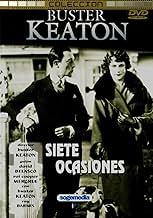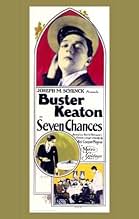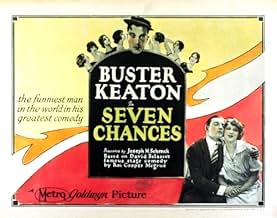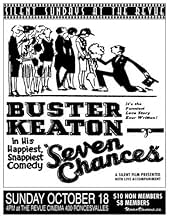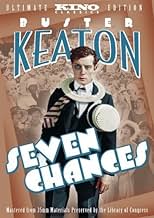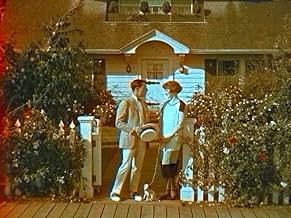IMDb-BEWERTUNG
7,8/10
12.605
IHRE BEWERTUNG
Ein Mann erfährt, dass er ein Vermögen erben wird, wenn er bis 19 Uhr an diesem Abend heiratet.Ein Mann erfährt, dass er ein Vermögen erben wird, wenn er bis 19 Uhr an diesem Abend heiratet.Ein Mann erfährt, dass er ein Vermögen erben wird, wenn er bis 19 Uhr an diesem Abend heiratet.
- Auszeichnungen
- 1 Gewinn & 1 Nominierung insgesamt
Frances Raymond
- Her Mother
- (as Frankie Raymond)
Jean Arthur
- Miss Smith - Office Receptionist
- (Nicht genannt)
Lori Bara
- Mother of Underage Girl
- (Nicht genannt)
Rosalind Byrne
- Hat Check Girl
- (Nicht genannt)
Louise Carver
- Prospective Bride Who Operates Crane
- (Nicht genannt)
Empfohlene Bewertungen
Jimmie Shannon (Buster Keaton) is a broker in need of money. When a lawyer comes to tell him he has inherited a certain sum, Jimmie avoids him thinking he may be bringing a summons. And then when he does hear the good news, there's a catch...
Directed by and starring Buster Keaton, this film portrays his particular brand of physical comedy, though perhaps not with as much danger as "The General" or as many tricks as "Sherlock Jr." The music of Robert Israel really carries this film. Not just because it's a silent film, but because it's great music -- moving, light and comedic. And there is an implied racial tone... Jimmie passes on proposing to both a Jew and a black woman.
I literally "laughed out loud" at this film! It is a shame Keaton considered it his worst film. Who knew it was so hard to get someone to marry you for $7,000,000 (in 1925 money, no less)?
Directed by and starring Buster Keaton, this film portrays his particular brand of physical comedy, though perhaps not with as much danger as "The General" or as many tricks as "Sherlock Jr." The music of Robert Israel really carries this film. Not just because it's a silent film, but because it's great music -- moving, light and comedic. And there is an implied racial tone... Jimmie passes on proposing to both a Jew and a black woman.
I literally "laughed out loud" at this film! It is a shame Keaton considered it his worst film. Who knew it was so hard to get someone to marry you for $7,000,000 (in 1925 money, no less)?
True love takes a lot of work - but this is ridiculous!
Jimmie Shannon (Buster Keaton) is a partner in a brokerage who can't quite bring himself to propose to Mary (Ruth Dwyer), the only woman he loves. Then, his business facing ruin, he discovers he stands to inherit a fortune if only he gets married that day. He proposes to Mary, but she's put off by his apparent insincerity. So Jimmie is left to find a woman, any woman, who will marry him. Will love prevail?
The film is an odd one for Keaton, starting off with a brief color sequence (in 1925) and moving quite slowly for Buster through the first third. The story was one Keaton had handed to him, rather than one he worked on himself, and feels at times like a "ladies' picture," focusing as it does on Jimmie's frustrated feelings and Mary's unhappiness.
For a while, Buster's not even the main laugh-getter in the film. For a while, he plays a kind of straight man to troll-visaged Snitz Edwards, playing the lawyer bringing the news of Jimmie's inheritance. Snitz chases after Jimmie and his partner, who think he's a process-server and dodge him, but Snitz prevails. Buster still pines for Mary, saying he can love no other woman (which she happens to hear over a telephone connection, changing her mind), but agrees to bring to bring a woman to church before the deadline out of loyalty to his partner.
"In case two show up, I'll marry the other," Snitz declares.
There are other oddities about "Seven Chances," like racial humor (Jimmie almost proposes to a black woman; a blackface actor plays a thick-headed hired hand) and the "Saphead"-style character Buster plays. It would seem like a lesser Keaton for that, but instead emerges as a masterwork of pacing and narrative. Just as you begin to settle in to "Seven Chances" tea-cozy aesthetic, it ramps things up for one of the great double-rally endings in movie history.
There's also a charming sequence where Jimmie tries to find a bride among a list of female members of his country club, the "seven chances" of the film's title. He burns through those chances in six minutes, and then gets rejected by a receptionist (Jean Arthur) and a hat-check girl (Rosalind Byrne) for good measure. The sequence plays with set design and framing to keep you always wondering as to what will happen next.
One amazing thing about the film you might not notice is the clever use of panning. Camera pans were still fairly new in cinema; framing was often stationary. But Buster is always in motion, and the camera moves with him. One clever shot, of Buster finding a turtle attached to his tie, apparently employs a treadmill in order to achieve an overhead camera angle.
The gags here keep coming, and give "Seven Chances" the feel of a classic Keaton short. Except there's a real story here to be told, and the humor always works to move the ideas forward. It's a classic demonstration of Keaton's ingenuity - even if he didn't have a hand in the film's conception or writing he directed it, and it shows - as well as his ability to find as many ways of making you laugh in as little time as possible.
Jimmie Shannon (Buster Keaton) is a partner in a brokerage who can't quite bring himself to propose to Mary (Ruth Dwyer), the only woman he loves. Then, his business facing ruin, he discovers he stands to inherit a fortune if only he gets married that day. He proposes to Mary, but she's put off by his apparent insincerity. So Jimmie is left to find a woman, any woman, who will marry him. Will love prevail?
The film is an odd one for Keaton, starting off with a brief color sequence (in 1925) and moving quite slowly for Buster through the first third. The story was one Keaton had handed to him, rather than one he worked on himself, and feels at times like a "ladies' picture," focusing as it does on Jimmie's frustrated feelings and Mary's unhappiness.
For a while, Buster's not even the main laugh-getter in the film. For a while, he plays a kind of straight man to troll-visaged Snitz Edwards, playing the lawyer bringing the news of Jimmie's inheritance. Snitz chases after Jimmie and his partner, who think he's a process-server and dodge him, but Snitz prevails. Buster still pines for Mary, saying he can love no other woman (which she happens to hear over a telephone connection, changing her mind), but agrees to bring to bring a woman to church before the deadline out of loyalty to his partner.
"In case two show up, I'll marry the other," Snitz declares.
There are other oddities about "Seven Chances," like racial humor (Jimmie almost proposes to a black woman; a blackface actor plays a thick-headed hired hand) and the "Saphead"-style character Buster plays. It would seem like a lesser Keaton for that, but instead emerges as a masterwork of pacing and narrative. Just as you begin to settle in to "Seven Chances" tea-cozy aesthetic, it ramps things up for one of the great double-rally endings in movie history.
There's also a charming sequence where Jimmie tries to find a bride among a list of female members of his country club, the "seven chances" of the film's title. He burns through those chances in six minutes, and then gets rejected by a receptionist (Jean Arthur) and a hat-check girl (Rosalind Byrne) for good measure. The sequence plays with set design and framing to keep you always wondering as to what will happen next.
One amazing thing about the film you might not notice is the clever use of panning. Camera pans were still fairly new in cinema; framing was often stationary. But Buster is always in motion, and the camera moves with him. One clever shot, of Buster finding a turtle attached to his tie, apparently employs a treadmill in order to achieve an overhead camera angle.
The gags here keep coming, and give "Seven Chances" the feel of a classic Keaton short. Except there's a real story here to be told, and the humor always works to move the ideas forward. It's a classic demonstration of Keaton's ingenuity - even if he didn't have a hand in the film's conception or writing he directed it, and it shows - as well as his ability to find as many ways of making you laugh in as little time as possible.
I love Seven Chances as much if not more than any of Keaton's other features, even if it does not enjoy the same reputation as The General or Sherlock, Jr. Using the sure-fire concept of a man who must take a wife or lose a fortune, Buster builds and executes one of his greatest extended gag sequences -- the chase of the reluctant groom by the army of brides. The first sections of the film detail Buster's inability to get anyone to take his proposal of marriage seriously, and then Buster pulls out all the stops on the famine to feast prospect once scores of women of all shapes and sizes begin to hunt down our hero while dressed in their wedding gowns. Seven Chances completely capitalizes on its comic potential, and Buster offers up another unbelievable tour de force of superb movie making.
This is a really sweet little Buster Keaton movie, with a greatly executed story.
Its story is fun enough to make the movie consistently a fun one. It's the sort of story that has copied a lot in movies ever since but also was used in movies before this one. It's even a popular subject for modern present day comedies. It perhaps makes "Seven Chances" seem less original than it in fact truly is of course.
The movie uses a lot of title cards. I mean, basically every line that gets spoken in the movie gets shown in a title card. It also makes the dialog part of the comedy of the movie. It isn't a much visual comedy, meaning that it doesn't really feature much slapstick or things like that. It's more a movie that relies on its comical situations and of course on the acting comical talent of Buster Keaton. Also the supporting cast is really more than great.
The movie begins a bit standard and perhaps even a bit slow but when the movie its story starts to take form the movie turns into one great laugh fest, with the last 20 minutes or so as the ultimate highlight, when things start to get really crazy and paced and the movie gets turned into one big non-stop comical chase! It's the one great fun moment after the other, with also some great and dangerous stunt work again from Buster Keaton himself!
A great Buster Keaton must-see, from the silent-era!
9/10
http://bobafett1138.blogspot.com/
Its story is fun enough to make the movie consistently a fun one. It's the sort of story that has copied a lot in movies ever since but also was used in movies before this one. It's even a popular subject for modern present day comedies. It perhaps makes "Seven Chances" seem less original than it in fact truly is of course.
The movie uses a lot of title cards. I mean, basically every line that gets spoken in the movie gets shown in a title card. It also makes the dialog part of the comedy of the movie. It isn't a much visual comedy, meaning that it doesn't really feature much slapstick or things like that. It's more a movie that relies on its comical situations and of course on the acting comical talent of Buster Keaton. Also the supporting cast is really more than great.
The movie begins a bit standard and perhaps even a bit slow but when the movie its story starts to take form the movie turns into one great laugh fest, with the last 20 minutes or so as the ultimate highlight, when things start to get really crazy and paced and the movie gets turned into one big non-stop comical chase! It's the one great fun moment after the other, with also some great and dangerous stunt work again from Buster Keaton himself!
A great Buster Keaton must-see, from the silent-era!
9/10
http://bobafett1138.blogspot.com/
Buster Keaton's comic genius makes "Seven Chances" a wildly entertaining film. The first half of it is quite good, if imperfect, but the second half is a tour-de-force of sustained humor and creativity. Keaton plays Jimmie Shannon, a young man who learns that he stands to inherit a fortune, but only if he marries by 7 PM that very day. It's the kind of goofy premise that in lesser hands could be a complete flop, but Keaton gets all kinds of possibilities out of it.
For most of the first half of the film, Jimmie is busy racing around proposing to every woman he can find. His true love, Mary, tries to find Jimmie herself, but he is already off on his frantic search for someone to accompany him to the altar. The search is always funny, at times extremely so. This first half has a handful of things that don't quite work, such as the black-faced servant (who was, though, probably intended as a sympathetic character), but if it were not for that and a couple other small details, this would be a nearly perfect film.
In the second half, all of the complications set up a frantic chase sequence, with literally hundreds (at least) of angry women pursuing Jimmie through the city, while he tries to get to Mary. This might be the best comic chase sequence ever filmed. It is hilarious and incredibly inventive, with careful choreography, a great variety of backgrounds, and a huge collection of gags both obvious and subtle. No description could do it justice - it has to be seen at least once to appreciate it.
If you are a fan of Keaton or of silent films in general, make sure to see this one.
For most of the first half of the film, Jimmie is busy racing around proposing to every woman he can find. His true love, Mary, tries to find Jimmie herself, but he is already off on his frantic search for someone to accompany him to the altar. The search is always funny, at times extremely so. This first half has a handful of things that don't quite work, such as the black-faced servant (who was, though, probably intended as a sympathetic character), but if it were not for that and a couple other small details, this would be a nearly perfect film.
In the second half, all of the complications set up a frantic chase sequence, with literally hundreds (at least) of angry women pursuing Jimmie through the city, while he tries to get to Mary. This might be the best comic chase sequence ever filmed. It is hilarious and incredibly inventive, with careful choreography, a great variety of backgrounds, and a huge collection of gags both obvious and subtle. No description could do it justice - it has to be seen at least once to appreciate it.
If you are a fan of Keaton or of silent films in general, make sure to see this one.
Wusstest du schon
- WissenswertesBuster Keaton had this project foisted upon him by producer Joseph M. Schenck, who had bought the rights to the hit Broadway show. Keaton later called it his least favorite feature and tried to keep film historian Raymond Rohauer from restoring the only known copy of the movie.
- PatzerJust as the horde of would-be brides overruns the college football game, one of the players can be seen throwing himself to the ground, already pretending to be trampled.
- Zitate
Title Card: By the time Jimmie had reached the church, he had proposed to everything in skirts, including a Scotchman.
- VerbindungenFeatured in 4 Clowns (1970)
Top-Auswahl
Melde dich zum Bewerten an und greife auf die Watchlist für personalisierte Empfehlungen zu.
- How long is Seven Chances?Powered by Alexa
Details
- Erscheinungsdatum
- Herkunftsland
- Sprachen
- Auch bekannt als
- Buster Keaton - Seven Chances
- Drehorte
- Chatsworth, Los Angeles, Kalifornien, USA(train scene)
- Produktionsfirma
- Weitere beteiligte Unternehmen bei IMDbPro anzeigen
Box Office
- Weltweiter Bruttoertrag
- 268 $
- Laufzeit
- 56 Min.
- Farbe
- Sound-Mix
- Seitenverhältnis
- 1.33 : 1
Zu dieser Seite beitragen
Bearbeitung vorschlagen oder fehlenden Inhalt hinzufügen

![Trailer [OV] ansehen](https://m.media-amazon.com/images/M/MV5BNTUxNzY1MzYtN2MzMS00Yzc0LWIyNmMtYTE1ZmJhYTlkMDI4XkEyXkFqcGdeQXRyYW5zY29kZS13b3JrZmxvdw@@._V1_QL75_UX500_CR0)

